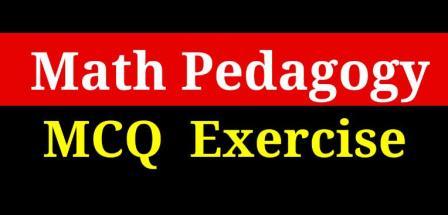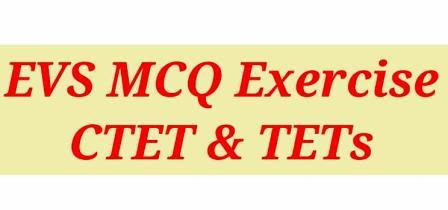In this following section of Math Pedagogy MCQ Exercise for CTET & TETs, 30 questions (MCQ) with 4 choices are given. Choose the right answer for each question. Answer of these important Math Pedagogy questions are available in the last of this post. Check how many of your answers are correct.
Maths Pedagogy MCQ Exercise
1- If a learner is having problem with numbers and calculations she/he maybe having disability known as
a) dysgraphia
b) dyscalculia
c) visual-spatial organisation disability
d) dyslexia
2- Mohan, a student of class IV, is able to answer all questions related to Number System orally but commits mistakes while writing the solutions of problems based on Number System. The best remedial strategy to remove errors in his writing is
a) to give him 10 practice tests
b) to relate real life experiences with mathematical concepts
c) to provide him a worksheet with partially solved problems to complete the missing gaps
d) to teach more than one way of solving problems of Number System
3- A teacher introduced multiplication in her class as repeated addition and then by grouping of same number of objects taken multiple times she introduced the ‘x’ symbol and further conducted a small activity of finding product using criss-cross lines or matchsticks. Here, the teacher is
a) providing remedial strategies for low achievers in Mathematics
b) using multiple representations to make the class interesting
c) developing a lesson and taking students from concrete to abstract concept
d) catering to learners with different learning styles
4- A teacher asks Rashmi of class V about the perimeter of a figure.
She also asked Rashmi to explain the solution in her words. Rashmi was able to solve the problem correctly but was not able to explain it. This reflects that Rashmi is having?
a) poor confidence level and poor mathematical skills
b) poor understanding of concept of perimeter but good verbal ability
c) lower language proficiency and lower order mathematical proficiency
d) lower language proficiency and higher order mathematical proficiency
5- Which of the following is not the objective of a diagnostic test in Mathematics?
a) To find out the weakness or deficiency of a child in learning
b) To fill progress report of children
c) To give feedback to the parents
d) None of the above
Read – Parts of Speech
6- When teaching addition of fractions, a teacher came across the following error?
1/2 + 1/3 = 2/5 what remedial action can the teacher take in such situation?
a) Help the child to understand the concept of LCM
b) Ask the child to practice as much as she can
c) No intervention is needed because she will understand as she grows
d) Help the child to understand the magnitude of each fraction
7- In an elementary class, a student commits mistake in multiplication of numbers in the way as 4×1=5, 5×1=6 etc. What type of remedial teaching programme should be planned?
a) Use visual presentation in shapes
b) More and more practice
c) Estimation
d) All of the above
8- To introduce the concept of fractions, a teacher can begin with
a) writing fractions in the form of a/b where b is not equal to 0
b) identifying fractional parts of things around them
c) identifying numerators and denominators of different fractions
d) finding fractions on a number line
9- When faced with word problems, Raghu usually asks “Should I add or subtract?”, “Should I multiply or divide?” Such questions suggest
a) Raghu lacks understanding of number operations
b) Raghu can not add and multiply
c) Raghu seeks opportunities to disturb the class
d) Raghu has problems in comprehending language
10- The purpose of diagnostic test in Mathematics is
a) to fill the progress report
b) to plan the question paper for the end-term examination
c) to know the gaps in children’s understanding
d) to give feedback to the parents
EVS MCQ Exercise Practice Set-1 for CTET & TETs
11- In a class, a teacher asked the students to define a quadrilateral in different ways – using sides, using angles, using diagonals etc. The teacher’s objective is to
a) help the students to explore various definitions
b) help the students to understand quadrilateral from different perspective
c) help the students to memorize all definitions by heart
d) help the students to solve all problems of quadrilateral based on definitions
12- Which of the following teaching-learning resources would be the most appropriate to teach the concept of addition of two decimal numbers?
a) Geo board
b) Beads and string
c) Graph paper
d) Abacus
13- A given rectangle and a parallelogram have the same area. However, many class IV student respond that the parallelogram has the larger area. How can a teacher help the students to understand that their area are the same?
a) Using paper folding
b) Using scale
c) Using a geo board
d) Using a graph paper
14- Manipulative tools are important for learners at primary level as they help them most to
a) speedup oral and mental calculations
b) perform better in examinations
c) understand basic mathematical concepts
d) solve word problems
15- Which one of the following manipulative tools is required to develop geometrical concepts of ‘symmetry’ and’ reflection’ in class IV?
a) Beads string
b) Dot paper
c) Abacus
d) Two sided counter
Read – Math Pedagogy Questions – MCQ Exercise Set-2 for TET
16- Some students of class II, faced difficulty in the addition of two-digit numbers involving ‘carry over’. Reason behind this problem is lack of
a) interest in Mathematics
b) understanding of difference between place value and face value
c) understanding the importance of zero
d) understanding of regrouping process
17- ‘Vedic Mathematics’ is becoming popular now-a-days especially among primary school children and is used to enhance
a) the algorithmic understanding of students in Mathematics
b) the problem solving skills of students in Mathematics
c) the concentration of students in Mathematics
d) the calculation skill and speed in Mathematics
18- At primary level use of tangram, dot games, patterns etc., helps the students to
a) understand basic operations
b) enhance spatial understanding ability
c) develop sense of comparing numbers
d) strengthen calculation skills
19- Geo-board is an effective tool to teach
a) basic geometrical concepts like rays, lines and angles
b) geometrical shapes and their properties
c) difference between 2D and 3D shapes
d) concept of symmetry
20- A student was asked to read the following numbers 306, 408, 4008, 4010. He reads as follows:
Thirty six, forty eight, four hundred eight, forty ten. The reason for error in reading is that
a) the student does not like Maths class and finds the class boring
b) the student has understood the concept of place value but does not know how to use it
c) the student is not fit for study of Maths
d) the student is not able to understand the concept of place value and feels comfortable using two digit numbers only
Famous Major Newspapers of the World
21- The most appropriate tool to expose the students of Class II to plane figures, its vertices and edges is
a) blackboard surface
b) geo board
c) nets of 3D solids
d) cubes
22- A child displays difficulty in differentiating between numbers, operations and symbols, two clock hands, different cins etc. This implies that the specific barrier affecting his learning is
a) poor motor skills, reading and writing skills
b) poor verbal, visual, auditory and working memory
c) poor visual processing ability i.e. visual discrimination, spatial organisation and visual coordination
d) poor language processing ability i.e. expression, vocabulary ad auditory processing
23- Use of Abacus in Class-II does not help the students to
a) understand the significance of place value
b) read the numbers without error
c) write the numeral equivalent of numbers given in words
d) attain perfection in counting
24- The concept of areas of plane figures can be introduced to the students of Class-V by
a) measuring the area of any figure with the help of different objects like palm, leaf, pencil, etc.
b) calculating the area of a rectangle by finding length and breadth of a rectangle and using the formula for area of a rectangle
c) stating the formula for area of rectangle and square
d) calculating the area of figures with the help of counting unit squares
25- “Problem solving” as a strategy of doing Mathematics involves
a) activity based approach
b) estimation
c) extensive practice
d) using clues to arrive at a solution
26- Which of the following can not be considered as a reason for fear and failure in Mathematics?
a) Classroom experiences
b) Symbolic notations
c) Structure of Mathematics
d) Gender difference
27- Which of the following problems from the textbook of Class IV refers to “multidisciplinary problem”
a) Draw the flag of India and identify the number of lines of symmetry in the flag
b) Draw the mirror image of a given figure
c) How many lines of symmetry are there in a given figure?
d) To draw a line of symmetry in a given geometrical figure
28- Possible indicator pertaining to visual memory barrier hampering with learner’s Mathematical performance is
a) difficulty in retaining mathematical facts and difficulty in telling time
b) difficulty in using a number line
c) difficulty to count on within a sequence
d) difficulty in handling small manipulations
29- A child of Class III reads 482 as four hundred eighty two but swites it as 40082. What does this indicate for a teacher?
a) Child is not attentive in the class is a careless listener
b) Child is a careful listener but has not established sense of place value
c) Child is confusing the expression of number in expanded form and in short form
d) Teacher should teach the concept of place value when the children are able to write numbers correctly
30- Which of the skills do you consider most essential for a teacher?
a) Encourage children to search for knowledge
b) Have all the information for the children
c) Ability to make children memorize materials
d) Enable children to do well in tests
Biology Questions for Competitive Exams
Read – Math Pedagogy Questions – MCQ Exercise Set-2 for TET
Answers of above Maths Pedagogy Practice Exercise for CTET & other TET
1(b), 2(c), 3(c), 4(d), 5(d), 6(a), 7(b), 8(b), 9(a), 10(c), 11(b), 12(a), 13(d), 14(c), 15(b), 16(d), 17(d), 18(b), 19(b), 20(d), 21(b), 22(c), 23(c), 24(a), 25(a), 26(d), 27(a), 28(a), 29(b), 30(a)
You may use ‘comment section’ below for your valuable comments/feedback.
Check Complete List – Competitive Exam Preparation

